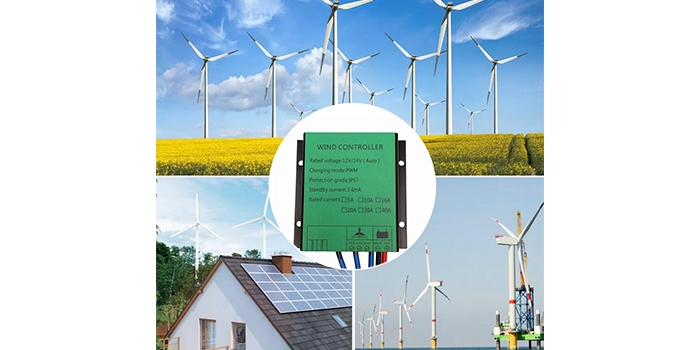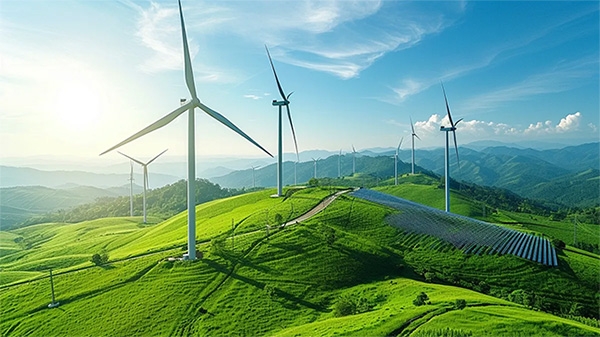As a renewable energy source, wind turbines have become an integral part of clean energy generation. To ensure a wind power system's stable and reliable operation, it’s essential to wire and connect the charge controller correctly. Proper wiring optimizes the turbine's output and protects system components from overloading and damage. Today we will discuss how to wire a wind turbine charge controller, covering the controller’s basic principles, wiring preparation, installation and wiring steps, and common troubleshooting tips.
What are the Basic Principles of a Wind Turbine Charge Controller?
A wind turbine converts wind energy into electricity through blade rotation, which drives a generator to produce current. Due to fluctuations in wind speed, the turbine's current output is unstable, requiring a charge controller to regulate it. The main functions of a charge controller include:
- Regulating Voltage and Current: Wind turbine output voltage and current fluctuate with wind speed. A charge controller stabilizes this output to levels suitable for batteries or energy storage devices, preventing system overload and voltage spikes.
- Charge Management: The controller detects battery charge status and stops charging when the battery is full, preventing overcharging.
- Overload and Discharge Protection: The controller has built-in overload and discharge protection. When the battery discharges to a low voltage, the controller disconnects it to extend battery life.
To select a suitable charge controller, consider the wind turbine’s output power, voltage, and battery capacity to ensure efficient system operation.

Preparation for Wiring
Before wiring, Inverter Online Shop recommends that you do the following preparations:
1. Determine the Charge Controller Location.
Choosing the right installation location is crucial. Ideally, the charge controller should be placed close to the battery to minimize cable length and reduce cable losses. Additionally, the controller should be located in a dry, well-ventilated area to avoid adverse effects from high temperatures or humidity.
2. Gather Necessary Tools and Materials.
- Cables: Choose cables with the appropriate specifications based on the wind turbine and controller’s output specifications. Ensure the cables can handle the necessary voltage and current.
- Insulation Tape and Cable Tubing: Used to protect cables from short circuits and wear.
- Circuit Breakers and Fuses: Add these during wiring to ensure system safety.
- Wire Terminals and Connectors: Secure cable connections to reduce the risk of poor contact.
3. Ensure Safety Precautions
Wiring involves electricity, and improper handling can lead to electric shock or short-circuit risks. Use insulated gloves, avoid working in damp environments, and, if necessary, turn off the wind turbine to ensure the system is not powered.
Steps for Wiring a Wind Turbine Charge Controller
Once the preparation is complete, you can start wiring the charge controller. The main wiring process includes the following steps:
- Connect the Wind Turbine to the Charge Controller. The first step is to connect the wind turbine’s output to the charge controller’s input. Follow these steps: Select suitable cables based on the controller’s input voltage and current specifications, then connect the turbine’s positive and negative terminals to the controller’s positive and negative input terminals, respectively. Ensure the connections are secure. Use a crimping tool to fasten the wire terminals to the cables for optimal contact and to avoid unstable currents or disconnections. Inspect the connections to ensure there are no exposed wires, which can prevent potential short circuits.
- Connect the Charge Controller to the Battery. After connecting the wind turbine, connect the controller’s output terminals to the battery. Key considerations include: Connecting the controller’s positive output terminal to the battery’s positive terminal and then connect the negative output terminal to the battery’s negative terminal. Installing an appropriately sized fuse or circuit breaker on the positive line is recommended to protect the battery from damage due to excessive current. Verify that connections are secure and that the polarity is correct to avoid damage caused by reverse polarity.
- Install Overload and Overvoltage Protection Devices. Wind turbine output current and voltage can vary due to wind speed fluctuations. To protect the system, you can install overload and overvoltage protection devices on the controller’s input and output terminals. Install an overload protector on the input side of the controller to ensure the current output from the turbine does not exceed the controller’s capacity. Install a voltage regulator or overvoltage protector on the output side to prevent high voltage from damaging the battery.
- Insulate and Secure the System. After wiring, insulate the cables to prevent exposed wires from contacting other metal objects. Additionally, use cable clamps to secure the cables in place and prevent them from coming loose.
- Verify Wiring Accuracy. After completing the wiring, thoroughly inspect the system to ensure all connections are tight, insulation is in place, and the wiring meets design specifications. Key inspection points include: Checking that all connections are secure and stable. Ensuring insulation materials cover all connections to prevent exposed wires. Checking for any signs of overheating at each terminal to prevent contact issues.

Important Considerations in Wind Turbine Charge Controller Wiring
During the wiring process, keep the following points in mind to ensure safe and stable system operation:
- Ensure Correct Polarity Connections: The charge controller’s positive and negative terminals must match the turbine and battery’s positive and negative terminals. Incorrect polarity can damage the controller or battery and even lead to safety hazards.
- Prevent Overloading and Short Circuits: Ensure that cables, connectors, and terminals can withstand the system’s maximum output power to avoid overloading. Also, prevent exposed wires and loose connections to reduce the risk of short circuits.
- Pay Attention to Grounding: Wind turbines and controllers typically need grounding to protect the equipment from electromagnetic interference, such as lightning. Select cables with appropriate specifications and ensure the grounding location is reliable.
- Waterproof and Dustproof Measures: Since wind power systems are generally installed outdoors, consider waterproofing and dustproofing during wiring. Use waterproof connectors and sealant to seal connection points to prevent water or dust from entering, which can lead to short circuits or equipment damage.
Troubleshooting and Maintenance
After wiring and starting the system, regular inspections and maintenance of the wind turbine charge controller wiring help extend the system’s life and improve operational efficiency. Common issues and solutions include:
- Unstable Current or Abnormal Voltage: If the battery voltage or current becomes unstable, it may be due to poor wiring connections or large current fluctuations from the wind turbine. Check all connection points for secure attachment, and ensure no loose connections.
- Overheating Controller: Overheating can be caused by excessive current or poor ventilation. Ensure the controller is installed in a well-ventilated location and that cable specifications meet system requirements to avoid overloading.
- Slow Battery Charging: Slow charging may be due to insufficient turbine output or low controller efficiency. Check the turbine’s operation and ensure the controller’s specifications are compatible with the system.
- Frequent Fuse Blowing: If fuses blow frequently, the current may be too high for the system. Check if the correct fuse specifications are used, or add an overcurrent protector during wiring to stabilize the current.
Conclusion
Wiring a charge controller for a wind turbine is a critical task that directly impacts the stability and safety of a wind power system. By following proper wiring techniques and implementing protective measures, you can maximize system efficiency and extend the equipment’s life. When wiring, focus on secure connections and safety, including waterproofing, dustproofing, and insulation. Regular inspection and maintenance help identify and resolve issues, significantly enhancing the system’s performance.
This guide from Inverter.com aims to provide valuable insights and instructions for professionals and enthusiasts involved in wind turbine wiring.
